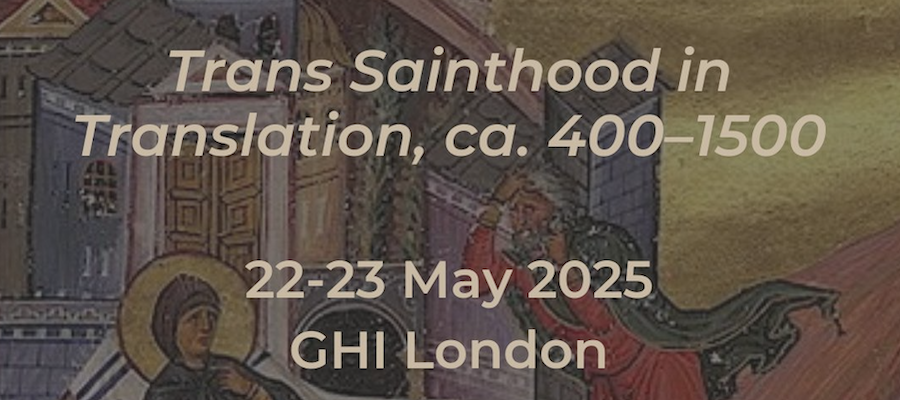Trans Sainthood in Translation, ca. 400–1500, German Historical Institute London, May 22–23, 2025
Trans saints – monachoparthenoi, saints who are initially described as female by their hagiographers, but transition to a male (often monastic) identity – are present in every late antique and medieval Christian tradition. The textual and artistic renderings of these figures offer a comparative key to conceptualizing trans bodies and trans souls across geographical and chronological boundaries. Binary cis-heteronormativity has long been portrayed as unchanging and unchangeable, as outside of the scope of history. This is a central plank in the playbook followed by transphobes worldwide, in the ever-escalating “culture war” against trans and queer people. Highlighting both the ubiquity and multivalence of premodern trans monks, and connecting across disciplinary divides to do so, is urgent work, not least because it provides a necessary counterpoint to such historically inaccurate rhetoric.
Following the insights of the “performative turn” in queer and trans studies that underscores the enactment and negotiation of gender identity through lived experiences, social practices, and narratives, we welcome explorations of gender and sexuality in the textual traditions in both East and West and in their translation. We also take into consideration aspects related to the ”performative turn” in visual studies in the last decade, as relevant for both medieval Eastern and Western hagiographic iconographies of trans saints, focusing on visual representations actively shaping identities and power dynamics and incorporating the embodied experience of the ritual practices.
While texts regarding fifteen trans saints are attested in the Eastern Mediterranean, this conference will focus on those whose vitae were available in Greek as well as in Latin: Eugenia*us, Euphrosyne*Smaragdus, Marina*us, Pelagia*us and Theodora*us. However, we particularly invite papers covering linguistic and artistic traditions beyond Greek and Latin, from Coptic to Old Norse. Taking seriously the connectivity of the Latin West, the Orthodox East, and the Islamic World in the Middle Ages, we adopt a trans-cultural comparative approach. Thus, contributions with a multilingual perspective are particularly welcome, as are those covering both textual and iconographic representations. Conference proceedings may be published as an edited volume.
We invite proposals for 20-minute papers. Possible questions include – but are not limited to – the following:
- How are the trans saints described as performing their gender? What gendered language is used in different traditions of their vitae?
- What role does sexual desire play in the performance of gender? Who is desirable to whom, and in what context?
- What role do familial ties (biological and spiritual) play in the construction of the trans saint’s gender?
- How does the trans saint’s performance of gender intersect with other aspects of their identity – religion, ethnicity, social status, age?
- How are trans saints translated – as texts (between languages), as relics (between places), as visual representations (from text to image)? Does re-writing/translating/visualizing a vita change the way the saint is gendered?
- Do different linguistic traditions of these vitae engage differently with locally important intertexts/spaces/etc.?
- How are trans saints materialized – in manuscripts, sculpture, iconography, cult spaces?
We welcome applications from scholars at any stage of their career, but particularly encourage early career researchers to apply. We are currently in the process of acquiring funding to cover at least part of the participants’ travel expenses.
Organizers: Mariana Bodnaruk (Masaryk University, Brno), Stephan Bruhn (GHIL) and Michael Eber (University of Oxford)
